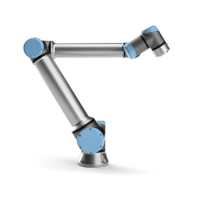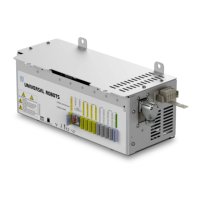5 Safety-related Functions and Interfaces
UR robots are equipped with a range of built-in safety-related functions as well as
safety-related electrical interfaces to connect to other machines and additional protec-
tive devices. Each safety function and interface is monitored according to ISO 13849-1
(see Chapter 8 for certifications) with Performance Level d (PLd).
NOTE:
If the robot discovers a fault in the safety system, e.g. one of the wires
in the emergency stop circuit is cut, or a position sensor is broken, a
category 0 stop is initiated. The worst case reaction time, from the
time an error occurs to the point in time that it is detected, and the
robot is stopped and powered off, is 1250 ms.
Part II of the PolyScope Manual describes configuration of the safety-related features,
inputs, and outputs. See Chapter 4 for descriptions on how to connect safety devices
to the electrical interface.
5.1 Limiting Safety-related Functions
The robot has a number of safety-related functions that can be used to limit the move-
ment of its joints and of the robot Tool Center Point (TCP). The TCP is the center point
of the output flange with the addition of the TCP offset (see Part II, the PolyScope
Manual).
The limiting safety-related functions are:
Limiting Safety
Function
Description
Joint position Min. and max. angular joint position
Joint speed Max. angular joint speed
TCP position Planes in Cartesian space limiting robot TCP position
TCP speed Max. speed of the robot TCP
TCP force Max. pushing force of the robot TCP
Momentum Max. momentum of the robot arm
Power Max. applied robot arm power
Advanced path control software decreases speed or issues a program execution stop
if the robot arm approaches a safety-related limit. Violations of limits will hence only
occur in exceptional cases. Nevertheless, if a limit is violated, the safety system issues
a category 0 stop with the performance listed in the table:
Version 3.1 (rev. 17782)
Copyright © 2009-2015 by Universal Robots A/S. All rights reserved.
I-39 UR5/CB3

